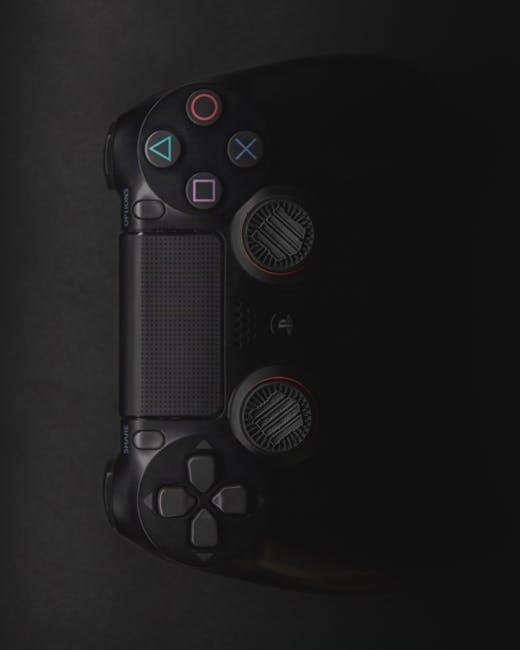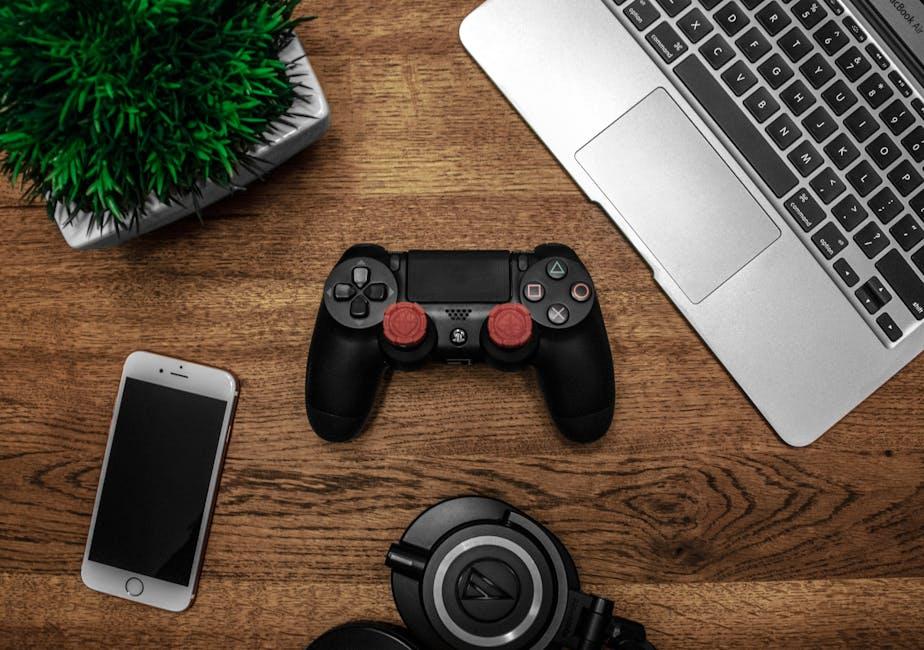Table of Contents
- Understanding the Basics of Game Controller APIs in JavaScript
- Exploring Different Game Controller Types and Their Compatibility
- Key Techniques for Implementing Game Controller Support in Your Web Applications
- Best Practices for Optimizing Game Controller Performance in JavaScript
- Enhancing User Experience with Custom Game Controller Configurations
- Q&A
- Key Takeaways


Understanding the Basics of Game Controller APIs in JavaScript
In the realm of web development, leveraging game controllers through JavaScript opens up a new dimension of interactivity. With the advent of the Gamepad API, developers can seamlessly integrate game controller support into their applications, allowing users to engage with their projects in a hands-on manner. This API enables JavaScript to communicate with various game controllers, transforming traditional mouse and keyboard interactions into immersive gaming experiences.
To effectively utilize the Gamepad API, it’s essential to understand its core components and functionalities. When a game controller is connected, the API provides vital information, including:
- Gamepad ID: Unique identifier for each controller.
- Axes: An array representing the analog joystick positions.
- Buttons: A list denoting the state of each button, including whether it’s pressed or not.
Implementing the Gamepad API is straightforward. Developers can begin by checking for gamepad support in the browser, using the following JavaScript code snippet:
if ("getGamepads" in navigator) {
// Gamepad API is supported
}Once support is confirmed, developers can access the connected gamepads, read their state, and create interactive elements based on user input. The critical step is to regularly poll the state of the gamepads within the animation loop, ensuring real-time responsiveness to player actions. Below is a simple structure to visualize how to retrieve and utilize gamepad data:
| Property | Type | Description |
|---|---|---|
| id | String | Unique controller identifier |
| axes | Array | Positions of analog sticks |
| buttons | Array | State of the buttons |


Exploring Different Game Controller Types and Their Compatibility
Gaming enthusiasts often find themselves navigating a variety of game controller types, each designed to enhance the player experience in unique ways. Wired controllers, for instance, provide a direct connection to consoles or PCs, ensuring minimal lag and uninterrupted gameplay. These controllers are typically plug-and-play, making them a straightforward choice for gamers who prioritize speed and reliability. In contrast, wireless controllers offer freedom of movement, allowing players to sit comfortably away from their screens without worrying about tangled cords. Although they may require periodic charging, the convenience they bring often outweighs this minor inconvenience.
In the increasingly diverse gaming landscape, compatibility becomes a fundamental consideration when selecting a controller. Many modern consoles, such as the PlayStation 5 and Xbox Series X, support a range of controllers from different manufacturers. However, not all controllers can seamlessly transition from one device to another. For example, while an Xbox controller may work with a PC, a PlayStation controller could require additional software to function properly. It’s essential for gamers to check compatibility details before purchasing to avoid frustration. Below is a quick reference table highlighting common controller types and their typical compatibilities:
| Controller Type | Common Compatibility |
|---|---|
| Wired Controllers | Consoles & PCs |
| Wireless Controllers | Consoles, PCs, & Bluetooth Devices |
| Universal Controllers | Multiple Platforms |
Another advancement in controller technology is the incorporation of specialized controllers, designed for specific genres or demographics. Racing wheels, flight sticks, and arcade-style joysticks provide immersive experiences for particular gaming styles, enhancing precision and responsiveness. These controllers not only improve gameplay but also make it more enjoyable, allowing players to engage fully with the gaming environment. As gaming continues to evolve, so too will the types of compatible controllers, ensuring that every gamer can find the perfect tool to match their style and preferences. By staying informed about new developments in game controller technology, players can make informed choices that elevate their gaming experience.
Key Techniques for Implementing Game Controller Support in Your Web Applications
Integrating game controller support into web applications can significantly enhance user experience, especially for gaming or interactive applications. To initiate this process, first, you need to make your web application acknowledge the game controllers available to the system. Utilize the Gamepad API, which allows you to detect and interact with gamepad devices. For instance, you can employ the navigator.getGamepads() method to retrieve the current gamepad states and check for input like button presses or joystick movements. The basic implementation revolves around listening for the user’s input and updating the interface accordingly.
Once the gamepad input is recognized, the next step is to map the inputs to relevant actions within your application. This typically involves creating a simple configuration object that links gamepad buttons to specific functions or commands in your app. For example:
| Gamepad Button | App Action |
|---|---|
| Button 0 | Jump |
| Button 1 | Attack |
| Axis Left | Move Left/Right |
To finalize the setup, ensure your application continuously monitors gamepad input to create a responsive experience. This is typically handled by setting up a game loop that processes input every frame, which can be achieved through functions like requestAnimationFrame(). By adjusting the frequency and manner in which you read input states, you can refine controls for optimum performance. Furthermore, consider providing settings for users to customize their controls, enhancing the overall accessibility and user satisfaction.


Best Practices for Optimizing Game Controller Performance in JavaScript
To ensure a smooth and responsive game controller experience in JavaScript, it is essential to understand the key components that influence performance. Handle event listeners with care; attaching too many listeners can lead to increased lag and delayed response time. Instead, focus on event delegation techniques which allow you to manage events efficiently by capturing them at a higher level in the DOM. This reduces the number of listeners and improves responsiveness.
In addition, testing across different browsers and devices is crucial for achieving optimal performance. Each platform may interpret controller input differently, affecting user experience. Utilize tools like BrowserStack or Sauce Labs to test across various environments. Collect data on latency and performance metrics to identify bottlenecks and areas for improvement. This proactive approach helps in building a consistent gaming experience, ensuring that users have the same level of responsiveness, irrespective of their setup.
Another important aspect is optimizing the game loop. The logic behind your rendering and input handling should be designed to minimize CPU usage and maintain frame rates. Consider employing techniques such as requestAnimationFrame for rendering and debouncing or throttling for input. Below is a simple summary table to illustrate different optimizations:
| Optimization Technique | Benefit |
|---|---|
| Event Delegation | Reduces event listeners, increasing performance. |
| Cross-Browser Testing | Ensures consistent performance across platforms. |
| requestAnimationFrame | Enhances rendering efficiency, maintains frame rate. |
| Input Debouncing | Minimizes unnecessary function calls, improving responsiveness. |


Enhancing User Experience with Custom Game Controller Configurations
Every gamer has a unique playing style, and customizing your game controller allows you to enhance that experience significantly. By utilizing JavaScript to create custom configurations, players can map actions to specific buttons that align seamlessly with their natural tendencies. This means that rather than struggling with default layouts, gamers can enjoy a more intuitive interaction with their favorite titles. With the right approach, you can adjust sensitivity, assign complex macros, or even remap controller layouts to improve ergonomics and efficiency.
For those looking to implement personalized settings, consider the following key benefits of custom game controller configurations:
- Improved Precision: Tailor sensitivity settings for better control over movements, enhancing your performance in competitive scenarios.
- Accessibility: Personalized layouts can minimize strain or discomfort, making gaming more accessible to players of all levels.
- Game-Specific Settings: Switch between configurations for different games, optimizing your controls for each unique gameplay dynamic.
To help you visualize some configurations, check out this simple table showcasing popular game titles and suggested button layout optimizations:
| Game Title | Optimal Layout | Recommended Sensitivity |
|---|---|---|
| First-Person Shooter | Jump: A | Crouch: B | Sprint: LT | High (8/10) |
| Racing Game | Accelerate: RT | Brake: LT | Drift: B | Medium (5/10) |
| Action RPG | Attack: X | Use Item: Y | Roll: A | Low (3/10) |
Q&A
Q&A: Game Controller JavaScript
Q1: What is Game Controller JavaScript?A1: Game Controller JavaScript refers to the use of JavaScript programming to interface with game controllers within web applications. Using the Gamepad API, developers can detect and respond to input from various game controllers, enabling a more interactive gaming experience directly in the browser.Q2: How does the Gamepad API work?A2: The Gamepad API allows web applications to access input from game controllers. When a user connects a game controller to their device, the API makes it possible to read the state of the controller, including button presses and analog stick movements. Developers can utilize this data to create immersive gaming experiences by coding responsive actions based on the controller’s input.
Q3: Do all browsers support the Gamepad API?A3: As of now, most modern browsers, like Chrome, Firefox, and Edge, support the Gamepad API, while Safari has limited support. It’s important for developers to check for browser compatibility before implementing features that rely on the API. User experience can be significantly enhanced by ensuring that the application runs smoothly across different platforms.
Q4: What types of game controllers can be used with Game Controller JavaScript?A4: The Gamepad API supports a wide range of game controllers, including Xbox controllers, PlayStation controllers, and generic USB gamepads. Even some mobile device controllers can be recognized. This flexibility allows developers to cater to various audiences, ensuring that most gamers can enjoy their web applications.
Q5: Can I create a game entirely in JavaScript using a game controller?A5: Absolutely! JavaScript provides a robust framework for creating games in the browser, and with the Gamepad API, you can incorporate controller inputs to enhance gameplay. Combining HTML5, CSS, and JavaScript, developers can create rich, interactive gaming experiences that allow users to control their actions using their preferred game controller.
Q6: What are some examples of games using Gamepad API?A6: Many indie games and web-based projects have successfully integrated the Gamepad API. Titles like “BrowserQuest” or “HTML5 Games” showcase how developers can utilize controller support to create engaging gameplay movements. A simple Google search will yield examples and source codes you can study and adapt for your own projects.
Q7: Are there any limitations to using Game Controller JavaScript?A7: While the Gamepad API is powerful, it does come with some limitations. Not all controllers will map correctly out of the box, requiring developers to write additional code to handle specific inputs. Additionally, features like vibration might not be supported across all browsers. Developers should also remain aware of accessibility issues, ensuring their games can be enjoyed by everyone.
Q8: How can I get started with Game Controller JavaScript?A8: To begin, make sure you have a recent version of a browser that supports the Gamepad API. From there, you can start by reading the API documentation, experimenting with examples, or even building a simple game project. Online tutorials and communities like GitHub offer a wealth of resources for aspiring developers looking to enhance their skills.
Game Controller JavaScript opens new avenues for web-based gaming, allowing developers to tap into the world of interactive play. By understanding the API’s nuances, programmers can create fun, engaging experiences that resonate with players.




0 Comments